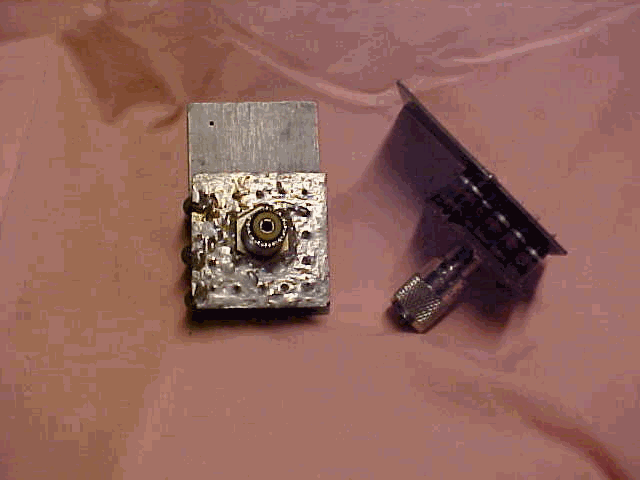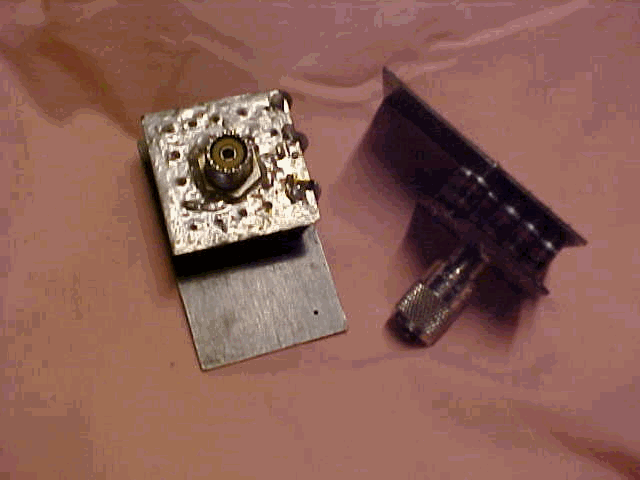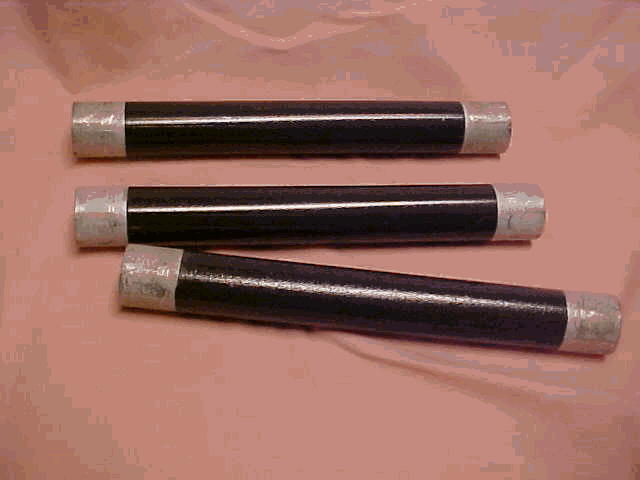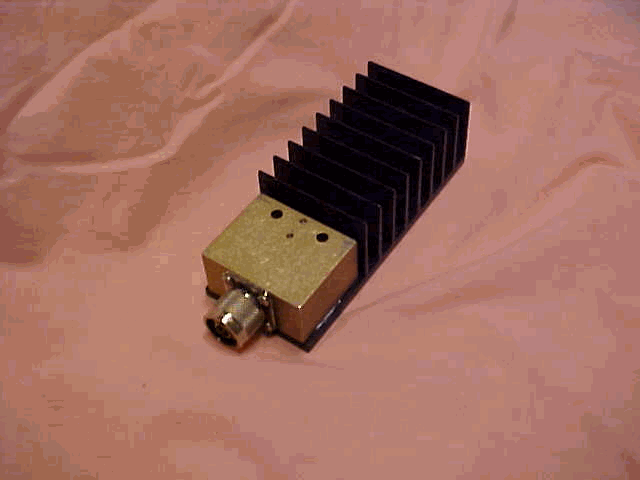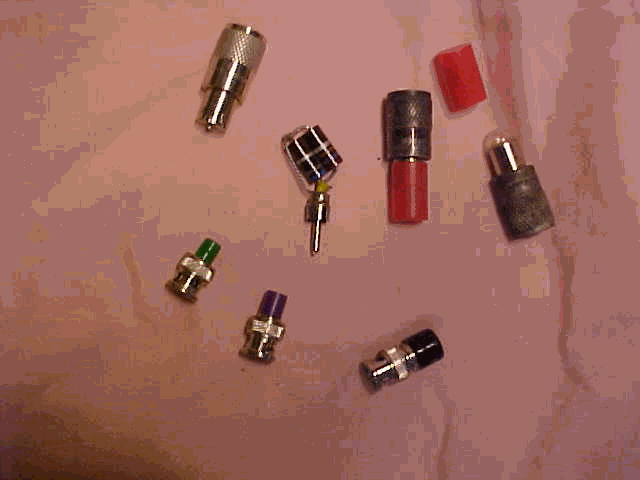K5LAD - 50+ Years of Ham Radio Memories
Volume XV
Hey, that's a bright idea........
Early memories of ham radio
Dummy loads have been around, in one form or the other, and have been a real benefit for the ham for many years. By tuning up on a dummy load you generally can save yourself from placing a signal on top of other hams’ QSOs. It’s the gentlemen’s or lady’s way of helping yourself and your station without bothering or hurting others.
| Nowadays you can buy commercially available dummy
loads or you can build a nice dummy load with just a handful of resistors: These two pictures show a couple of dummy loads I’ve built using 20-22 1000 ohm 2 watt carbon resistors and two pieces of PC board materials. You’ll notice that one has a built-in PL-259 plug and the other has an SO-239 socket but both units are quite useful and have both been used for more than 30 years. The power rating would be a function of the power rating on the resistors used or approximately 40-45 watts and they should handle that power for a good 5-10 minutes without problems. |
|
|
They will also allow the user to tune up their
100-watt output transceiver for a short key-down period -- not continuously for several
minutes. The ‘touch test’ will let you know when it’s time to stop
transmitting and give it a chance to cool. I’ve even seen this type of parallel
resistor load placed in a bucket of transformer or mineral oil to increase its power
rating. Since the resistors used were not precision, it required a couple of extra resistors paralleled to get it closer to the desired 50 ohms. |
You can also find some of the documentation for equipment used during World War II and they often referred to a "phantom antenna" which was another name for a dummy load. Present day readers of that term might get the creeps since it’s kinda spooky.
|
Here are pictures of some non-inductive resistors I bought at a hamfest a few years ago. They are 150 ohms each and could handle, in free air, probably about 250 watts each. They are 8" long and 1" in diameter and are more than twice as large as the single 50-ohm resistor, which was used in the Heath Cantenna. When the three are placed in parallel, I’ll have my 50 ohms. Note that the non-inductive designation is very important or else they will be just like hooking up several coils and this would severely restrict the usable frequency range. |
You should
never attempt to use any of the regular old wire-wound power resistors, i.e., the kind
that are available in many different sizes and values and found in most hams’ junk
boxes. Some non-inductive resistors are made of wire materials just like a regular
wire-wound power resistor but the center of the wire winding starts in the center of the
form and each end is wound in the opposite direction, thus canceling out the inductance
from the coils. Others, like the ones in this picture, are made of a carbon composition
material that is made to dissipate a large amount of heat. There are no wire leads on
these resistors and they are typically placed in a clip device made to hold large fuses.
|
||||
|
||||
| The items on the right
are small dummy loads that cannot dissipate much power. They are handy for calibrating
antenna equipment and can stand several watts for short periods. Handy for use with
VHF/UHF talkies.
Top row (L to R): 1. 5 watt enclosed 50 ohm 2. Homebrew in a hurry – 2 resistors in parallel that equaled 50 ohms 3. The last 2 are old CB dummy loads made up of a bulb inside of the PL-259. It would blink on modulation peaks. The red hat gave it that extra class and hid the insides from the user. |
Bottom row (L to R): 1 & 2. Small ½ watt BNC loads, often used in older networks. The green top designated 50 ohms and the purple top was 75 ohms 3. The BNC with a black top actually is imprinted with the words, "BNC Male Terminator 50 ohms +/- 1%. The first time a guy reads that "Male Terminator" message causes him to hesitate for just a bit. |
|||
One of the most popular dummy loads --- EVER --- was the Heath Cantenna sold as a kit for several decades. It had a non-inductive resistor that was suspended in a gallon of transformer oil or mineral oil, whatever the builder had found to use. The kit did not come with the oil so it was up to the builder to procure that. The resistor was mounted coaxially to keep leads at a minimum so the unit was speced to operate well up to the 2 meter frequencies. These kits were sold back in the 60s and 70s when it was determined that older transformer oil (such as that used in the big "pole pig" transformers hanging on a pole out behind your house) had PCBs which were carcinogenic or cancer causing. All those transformers have now had their oil replace by a non-PCB oil but many, many of the older Heath Cantennas still have the original oil from the day the kit was finished and it is probably a PCB type oil unless it was deliberately changed. Caution – when in doubt, change it out. Also, as an additional note, if you buy one of these units used, check it carefully to make sure this is no degradation of the can it is in. I’ve seen several that had a hole in the can and the oil will slowly (usually) drain out on your [good] floor. It’s a good idea, even if it is in original shape, to place it on some protection device like a piece of wood or inside an old cheap plastic bucket [which has no holes].
I guess I could tell a story on myself and my Cantenna. In the early 1970s, after I had built my home-brew 4-1000A amplifier, I decided to see just how much "goo" I could get from it. The 4-1000A will easily work with 5000 volts at an amp for 5000 watts input and an output up around 3000 watts, but my power supply was not that high and my tube had many hours already on it. I just wanted to be sure if I could get a full 1500 watts out so I hooked it up on 40 meters into my Cantenna, just to make it legal. The amplifier tuned up and I was getting somewhere between 1500 and 2000 watts and I was enjoying, with glee, watching through the protective guard screen as the plate glowed a bright cherry red. After several minutes I decided that I had my answer so I unkeyed and sat down in my operating chair. For some reason, I was bare-footed and the Cantenna was tucked away under my table on a piece of pine board.
One of my toes touched the side of the can on the Cantenna and promptly burned a place on my toe. The resistor inside had gotten so hot that it boiled the transformer oil (venting a bunch of it out the top) and heated up the can hot enough to do me some toe damage. I never did that again…. at least for that long a time. I measured the resistor and it had gotten so hot that it was no longer 50 ohms but was up in the mid 70 ohm region, as I recall. I do know that I had to order a new non-inductive 50 ohm resistor for my Cantenna. Lesson learned at the cost of a new resistor and a blister on the toe.
The Dentron Big Dummy has been written about previously and it was shipped already built with a gallon jug of non-PCB oil included in the price so those units are safe, regardless of their age.
I recently got a 2009 MFJ catalog and they have several dummy loads. Some are "dry" loads and some even have a wattmeter attached. They also sell a ‘2500 watt fan-cooled dry Dummy Load’ if you’re needing to dissipate that much power. Their can-type dummy load is designated as the MFJ-250X and you can buy it without transformer oil for $49.95 or $69.95 with the oil. You can even buy a gallon of transformer oil, from MFJ, for $29.95 if you’re building your own. I’m guessing, without doing any checking, that you could get a gallon of mineral oil from a drugstore or a place which sells horse care supplies, for a LOT less money.
I also once had a dummy load made of 12 big non-inductive 600-ohm resistors I had received via Army MARS many years ago. I took two pieces of galvanized sheet steel (about 1 foot square, as I recall) and punched 12 holes in each sheet (about 1" holes, if memory serves me correctly). These 600 ohm resistors were probably rated at more than 300-500 watts each so they were heavy duty. Each resistor was about 15" or so long and about 1" in diameter. This made a giant dummy load that should have easily handled 4000-5000 watts output in open air. Even though the resistors were mounted very close together with minimum lead length, it wasn't a very good load for VHF and UHF but it was perfect for low band frequency. Unfortunately, I loaned it to a local ham by the name of Dennis and he left town with my giant dummy load. I'm not accusing him of the theft of my giant dummy load but it's been 30+ years and he still has it and I don't, so I'm beginning to get suspicious that he doesn't plan to return it to me.
To explain the title of this article, before the availability of these kits, home-builts, and buildable dummy loads, most hams used a regular old incandescent light bulb for a dummy load. You could see actual power indication from the brightness of the bulb. On CW it would blink in time with the characters and on AM, you could watch the brilliance fluctuate, as it would get brighter on voice peaks.
Resistance varied according to the power being fed to it, hence the temperature of the filament. You might think the best bulb size would be a larger one but usually the smaller bulbs were closer to 50 ohms at their full brilliance/temperature. Actually the size typically used was whatever was in the pantry or if none were there, the closest bulb in the most conveniently reached lamp. Ham’s wives knew that if they needed a replacement bulb for the living room, one could probably be found around the ham’s collection of equipment.
Actual resistance of the bulb didn't matter since the pi network on the output of tube-type transmitters could match a wide range of impedance (resistance). Current solid-state radios don't have adjustments for matching since, by design, they expect and require to see 50 ohms. If 50 ohms is not present at the antenna jack, an antenna tuner is required. Failure to make the proper match will usually cause the solid-state transmitter output to fold back (decrease) to protect itself [if you’re lucky].
There were numerous advantages to using an incandescent light bulb for a dummy load:
They were cheap, quickly available, and easily replaceable. They were also fun to watch blink in time with your sending when practicing code sending. In additional to that, it was actually possible to work some contacts on a light bulb. Most hams had a screw-in socket (usually ceramic) with a short piece of RG-58 coax, connected to a PL259. I tried to find my old light bulb dummy load to get a picture of it too but, alas, it seems to be retired to my past.
Many old-time hams have stories from their Novice days of making contacts while using a light bulb dummy load. It was also possible to work across town with a Cantenna or Big Dummy although the radiator (resistor) was encased in a grounded shield (the one gallon paint can). Just as an experiment, if you now have a "paint can" dummy load, tune your receiver to a medium strength signal and then remove the antenna and replace it with your dummy load. You'll be surprised that, although the signal is noticeably lower, you can still copy them OK. If their signal can get into your shielded can, your transmitted signal can also escape for others to hear --- not a big signal but an actual signal. Be careful what you say when you’re on that dummy load as others can possibly hear you.
Regardless of what type of dummy load you own, it only works when you hook it up. It’s a common courtesy to use that dummy load when testing a transmitter and to not bother someone on the air who in participating in a QSO. Whether you use a fancy dummy load with a meter, an over-temperature alarm, and who knows what else or you only use a light bulb it’s nice to know that you can test with your transmitter and not bother others too much. Besides, …………….it is a really bright idea.
Jim – K5LAD written July 5, 2009
Page visited 1019 times
